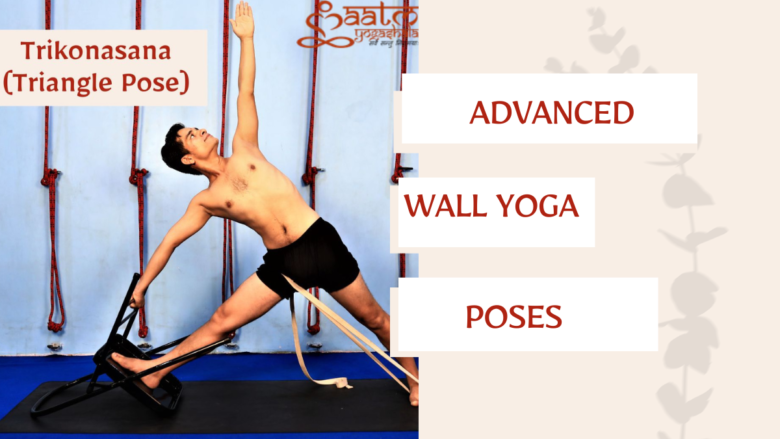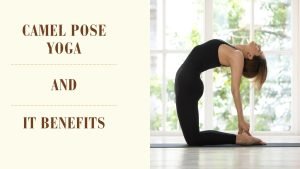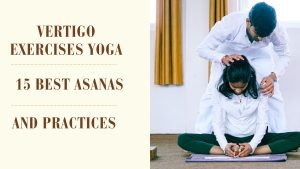Explore the fascinating world of Wall Yoga Poses at Aatm Yoga Shala, where a single surface can be the catalyst for deeper stretches, enhanced alignment, and a practice that hones both body and mind. Whether you’re a seasoned yogi or a newcomer to the mat, the support and structure offered by the wall at Aatm Yoga Shala can profoundly change your yoga dynamics, paving the way for new growth in your practice.
In this comprehensive guide, we’ll take a holistic approach to wall yoga poses, unveiling basic and advanced poses, expounding on the remarkable advantages, and providing tips to integrate these asanas into your regimen safely and effectively at Aatm Yoga Shala.
You’ll discover that by incorporating your environment into your yoga practice, the wall becomes a trusted ally in your path to vitality and wellbeing at Aatm Yoga Shala.
Understanding Wall Yoga Poses: What It Is and Why It Matters
Wall yoga, as the name suggests, involves practicing yoga postures with the support of a wall. This simple yet effective addition creates a practice that is both accessible and challenging. It’s perfect for those recovering from injuries, beginners building strength, or advanced practitioners seeking to refine their technique.
The extra support from the wall aids in alignment, balance, and the ability to hold poses for a longer duration, contributing to a heightened sense of awareness and a deeper stretch. The increased stability empowers practitioners to explore inversions with growing confidence, a practice that is not only exhilarating but also therapeutic.
Basic Wall Yoga Poses to Ground and Align
Start your wall yoga poses exploration with foundational poses that establish the connection between your body and the support of the wall. These asanas form the bedrock of your wall yoga poses practice, laying the groundwork for more complex poses and fostering a sense of security in your movements.
Supported Mountain Pose (Tadasana)
Stand with your back against the wall, feet hip-width apart. Gently press the entire backside of your body into the wall, finding alignment from head to toe. This pose promotes good posture and acts as a starting point for other standing poses.
Wall Plank
Begin in a standing position with the back of your body against the wall. Step your feet forward and lean your torso back, returning your hands to the wall at shoulder height. Your body should form a straight line from heels to head. Engage your core, and hold here for several breaths.
Legs-Up-the-Wall Pose (Viparita Karani)
Sit sideways next to the wall, with your upper body facing away from it. Gently lie down on your back and extend your legs up the wall. Your hips should be in line with the wall. This restorative pose promotes blood circulation and can alleviate stress and fatigue.
What are two benefits of the wall yoga poses practice?
1.Wall yoga poses provides a myriad of health benefits, with two notable ones being improved balance and enhanced focus. Firstly, the wall acts as a stabilizing force, aiding practitioners in fine-tuning their balance. This is particularly beneficial in poses where maintaining equilibrium is challenging, enabling yogis to explore and hold asanas with greater confidence and safety.
2.Secondly, practicing against a wall demands increased concentration, as the physical support allows practitioners to pay closer attention to their alignment, breathing, and the subtler aspects of each pose. This heightened focus during practice can translate to improved mindfulness and presence in daily life.
“Facing the wall in a handstand invites you to confront your fears and trust your strength. The wall doesn’t just support you; it challenges you to push beyond your limits.” – Aatm Yogashala
10 Advanced Wall Yoga Poses
1. Handstand (Adho Mukha Vrksasana)
Steps: Begin with your hands on the ground, a few inches away from the wall. Kick your legs up, one at a time, finding balance as your feet touch the wall. Keep your arms strong, shoulders aligned over your wrists, and engage your core.
Benefits: Strengthens the shoulders, arms, and wrists, improves balance, and energizes the body.
2. Forearm Stand (Pincha Mayurasana)
Steps: Starting on your forearms, ensure they are parallel and your elbows shoulder-width apart. Kick up gently, allowing your legs to rest against the wall. Engage your core and leg muscles for stability.
Benefits: Builds upper body strength, enhances balance, and focuses the mind.
3. Wall-Assisted Split (Hanumanasana)
Steps: Begin in a low lunge with your back foot against the wall. Gradually straighten your front leg and slide your back leg up the wall into a split position. Hold for breaths, and then switch legs.
Benefits: Deeply stretches the hamstrings and hip flexors, promotes emotional release.
4. Wall Walks
Steps: Start in a plank position with your feet against the wall. Walk your feet up the wall as you simultaneously walk your hands back towards it, coming into a handstand position. Walk back down.
Benefits: Builds shoulder and core strength, improves coordination and balance.
5. Inverted L Pose
Steps: Place your hands on the floor a few feet away from the wall and walk your feet up the wall until your body forms a 90-degree angle. Keep your arms and legs straight, pressing firmly into the ground.
Benefits: Strengthens the upper body and core, stretches the legs, and improves blood flow to the brain.
6. Wheel Pose with Wall Support (Urdhva Dhanurasana)
Steps: Begin lying on your back, feet flat on the floor and close to the wall. Push your hands and feet into the floor to lift your body into a wheel, using the wall to support your feet or hands.
Benefits: Opens up the chest and shoulders, strengthens the arms and legs, and increases spine flexibility.
7. Extended Triangle Pose with Wall Support (Utthita Trikonasana)
Steps: Stand in a wide stance, extending your arms parallel to the floor. Tilt at the hips to touch the wall with one hand, elevating the other towards the ceiling. Look towards the raised hand.
Benefits: Stretches and strengthens the thighs, knees, and ankles, while also reducing anxiety.
8. King Pigeon Pose with Wall Support (Eka Pada Rajakapotasana)
Steps: From a position with your hips facing the wall, place one foot against the wall and slide your other leg back, lowering the hips toward the floor. Lean back and reach for your raised foot with both hands.
Benefits: Opens up the hips, chest, and shoulders, and improves flexibility in the back.
9. Wall-Assisted Warrior III (Virabhadrasana III)
Steps: Begin in a standing position a few feet away from the wall. Lean forward to place your hands on the wall, extending one leg straight back. Your body and raised leg should form a T-shape.
Benefits: Strengthens the ankles and legs, tones the abdomen, and improves balance and posture.
10. Arm Pressure Pose with Wall Support (Bhujapidasana)
Steps: With your back to the wall, place your hands on the ground, and slowly lift your feet off the ground, crossing them at the ankles. Use the wall to press your back against for balance.
Benefits: Increases arm and shoulder strength, improves balance, and focuses the mind.
Also read :200 hour yoga ttc and its benifits
Benefits of Wall Yoga
The benefits of wall yoga poses extend beyond the mat, influencing the body and mind in profound ways. Explore the unique advantages that this practice offers, and how it can augment your overall yoga experience.
Enhanced Alignment and Posture
The wall acts as a constant guide, allowing you to check and correct your alignment. This awareness not only aids in posture during practice but can also carry over into everyday life, creating a mindful approach to movement.
Deeper Muscle Stretches
The support of the wall in asanas like Downward Facing Dog or Pigeon Pose provides the opportunity to deepen your stretch safely and for a longer period, as the wall assists without allowing you to over-extend.
Improved Inversions Practice
The wall offers a gradual introduction to inversions, supporting you as you gain the strength and confidence to perform poses like headstand or handstand without the fear of falling.
Safety and Effectiveness Tips for Wall Yoga
To enjoy the full benefits of wall yoga, it’s essential to practice with safety and mindfulness. These tips will help you maintain a practice that’s both effective and injury-free.
Listen to Your Body
Pay close attention to how your body feels in each pose. Sensations of discomfort or pain are signals to ease off or modify the posture. Your practice should be challenging, but never to the point of strain or injury.
Use Props When Necessary
Don’t be afraid to use additional props such as blankets, bolsters, or yoga blocks to customize your wall yoga poses practice. They can enhance support, stability, or ease of movement.
Breathe and Be Present
Remember that the breath is the foundation of yoga. Inhale deeply to help you expand and exhale fully to deepen into each pose. Stay present with your breath and the sensations in your body.
Incorporating Wall Yoga poses Into Your Daily Routine
Consistency is key to any yoga practice, and wall yoga poses is no exception. Discover how to seamlessly weave these poses into your daily life, reaping the rewards one stretch at a time.
Create a Dedicated Space
Designate an area where you have ample space and a clear wall to practice against. Make it inviting, with a few personal touches like candles, incense, or inspiring decor.
Morning and Evening Routines
Begin or end your day with a few minutes of wall yoga. A morning practice can invigorate you for the day ahead, while an evening session can help release tension and prepare you for a restful night’s sleep.
Weekly Wall Yoga Sessions
Plan for at least one focused wall yoga poses session per week. This can be a deeper practice, with a variety of poses and a longer duration, perhaps even incorporating a meditation or pranayama session.
Conclusion Wall Yoga
Wall yoga is a practice that combines simplicity with profound impact. It invites us to explore the support of the wall as an extension of the ground beneath us, offering stability, alignment, and a fresh perspective on familiar asanas. Whether you’re seeking to deepen your stretches, refine your technique, explore inversions, or simply vary your practice, wall yoga is a tool that can benefit practitioners of all levels.
The wall is waiting for you. Quiet your mind, deepen your breath, and allow your yoga practice to scale to new heights with every pose you brave. There’s a world of balance, strength, and flexibility just beyond the threshold, and it’s time to step into it, with the wall by your side. Take the first step and see how wall yoga poses can transform your practice, and in turn, your life.Book Now
Frequently Asked Questions About Wall Yoga
Can Anyone Practice Wall Yoga?
Absolutely! Wall yoga poses is suitable for practitioners of all levels, from beginners to advanced yogis. The wall serves as a supportive tool, making various poses more accessible and aiding in the correct alignment and balance. However, if you have specific health concerns or injuries, it’s best to consult with a healthcare provider or a qualified yoga instructor before starting.
Do I Need Special Equipment for Wall Yoga?
While no special equipment is required, having a few basic yoga props can enhance your practice. A yoga mat, yoga blocks, a blanket, and a bolster can provide additional support and comfort during your wall yoga poses sessions. Otherwise, all you really need is a clear wall space and the willingness to explore your yoga practice.
How Often Should I Practise Wall Yoga?
The frequency of your practice depends on your personal schedule and goals. Incorporating wall yoga poses into your regular yoga practice 1-2 times a week can significantly impact your overall strength, flexibility, and posture. However, even a few minutes of wall yoga poses daily can yield noticeable benefits.
What Are the Best Wall Yoga Poses for Beginners?
For those new to wall yoga, some great poses to start with include the L-Shaped Handstand Prep for building core strength, Wall Supported Warrior III for balance and leg strength, and a Wall-Assisted Downward Facing Dog for stretching the back and legs. These poses provide a solid foundation and allow beginners to get comfortable with using the wall as support.
How Can I Make Sure I’m Practicing Wall Yoga poses Safely?
To ensure a safe practice, always listen to your body and avoid pushing into pain or discomfort. Use props to modify poses as needed and pay attention to proper alignment. If you have any concerns or questions, don’t hesitate to consult with a qualified yoga instructor for personalized guidance. And most importantly, always approach your practice with mindfulness and awareness. Keep your breath steady and be present in each pose to prevent injury and fully reap the benefits of wall yoga.




